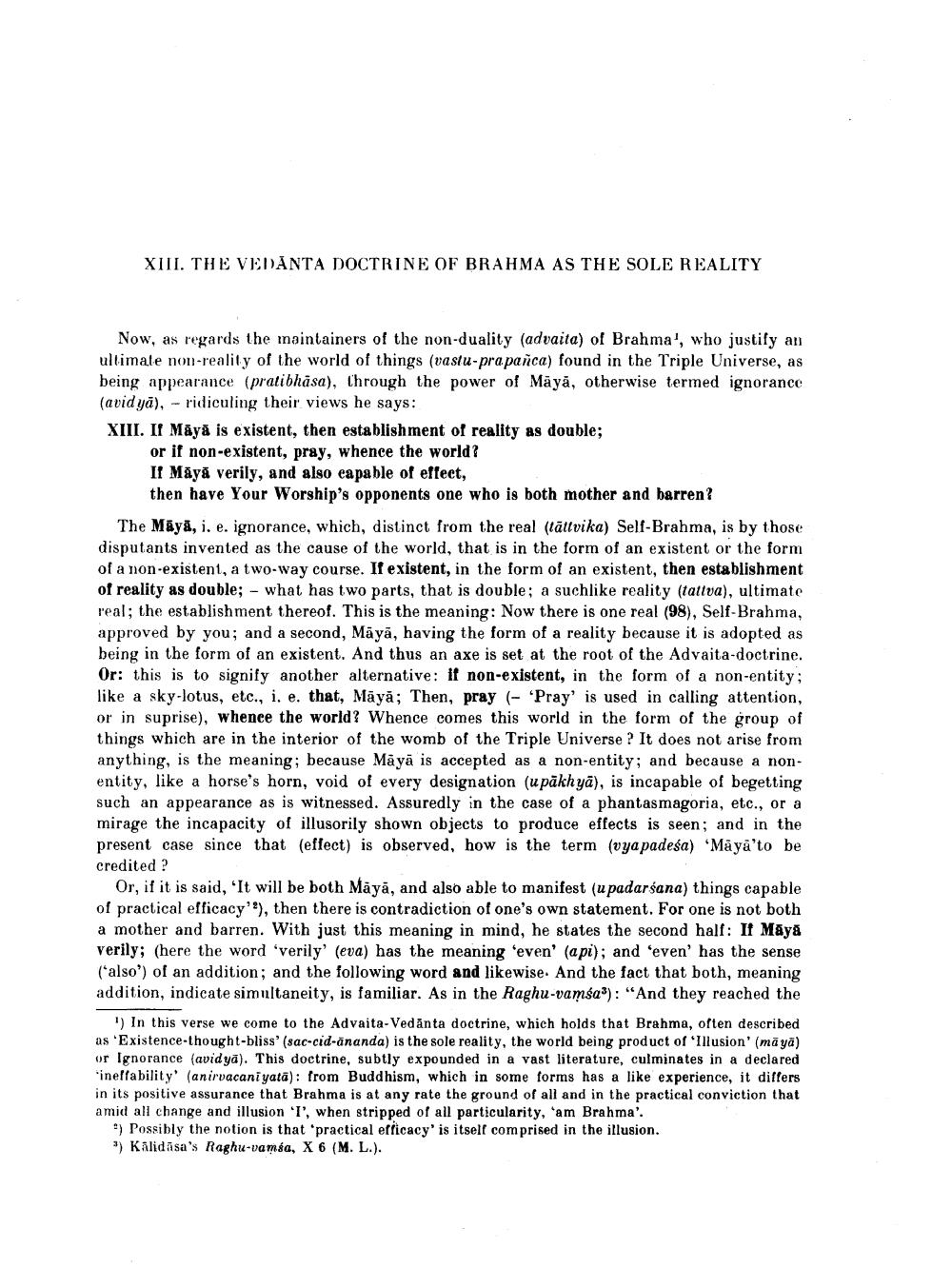________________
XIII. THE VEDANTA DOCTRINE OF BRAHMA AS THE SOLE REALITY
Now, as regards the maintainers of the non-duality (advaita) of Brahma1, who justify an ultimate non-reality of the world of things (vastu-prapanca) found in the Triple Universe, as being appearance (pratibhasa), through the power of Maya, otherwise termed ignorance (aridya), ridiculing their views he says:
XIII. If Maya is existent, then establishment of reality as double;
or if non-existent, pray, whence the world?
If Maya verily, and also capable of effect,
then have Your Worship's opponents one who is both mother and barren?
The Maya, i. e. ignorance, which, distinct from the real (tättvika) Self-Brahma, is by those disputants invented as the cause of the world, that is in the form of an existent or the form of a non-existent, a two-way course. If existent, in the form of an existent, then establishment of reality as double; - what has two parts, that is double; a suchlike reality (tattva), ultimate real; the establishment thereof. This is the meaning: Now there is one real (98), Self-Brahma, approved by you; and a second, Māyā, having the form of a reality because it is adopted as being in the form of an existent. And thus an axe is set at the root of the Advaita-doctrine. Or: this is to signify another alternative: if non-existent, in the form of a non-entity; like a sky-lotus, etc., i. e. that, Maya; Then, pray (- 'Pray' is used in calling attention, or in suprise), whence the world? Whence comes this world in the form of the group of things which are in the interior of the womb of the Triple Universe? It does not arise from anything, is the meaning; because Maya is accepted as a non-entity; and because a nonentity, like a horse's horn, void of every designation (upäkkyd), is incapable of begetting such an appearance as is witnessed. Assuredly in the case of a phantasmagoria, etc., or a mirage the incapacity of illusorily shown objects to produce effects is seen; and in the present case since that (effect) is observed, how is the term (vya padeśa) 'Maya'to be credited ?
Or, if it is said, 'It will be both Maya, and also able to manifest (upadarsana) things capable of practical efficacy'), then there is contradiction of one's own statement. For one is not both a mother and barren. With just this meaning in mind, he states the second half: If Māyā verily; (here the word 'verily' (eva) has the meaning 'even' (api); and 'even' has the sense (*also') of an addition; and the following word and likewise. And the fact that both, meaning addition, indicate simultaneity, is familiar. As in the Raghu-vamsa3): "And they reached the
1) In this verse we come to the Advaita-Vedanta doctrine, which holds that Brahma, often described as 'Existence-thought-bliss' (sac-cid-ananda) is the sole reality, the world being product of 'Illusion' (māyā) or Ignorance (avidya). This doctrine, subtly expounded in a vast literature, culminates in a declared ineffability' (anirvacani yata): from Buddhism, which in some forms has a like experience, it differs in its positive assurance that Brahma is at any rate the ground of all and in the practical conviction that amid all change and illusion 'I', when stripped of all particularity, am Brahma".
*) Possibly the notion is that 'practical efficacy' is itself comprised in the illusion. 3) Kalidasa's Raghu-vamsa, X 6 (M. L.).




